Bobtail Cat - £25.00
Bobtail Cat
£25.00
Celebrate feline charm with this digital illustration of a Bobtail Cat, beautifully capturing its distinctive short tail and soft features. The turquoise-blue background provides a fresh, modern contrast, making this portrait perfect for cat lovers and art enthusiasts alike.
Part of our Pet Series, this artwork blends clean digital linework with vibrant color to create a piece that’s playful yet elegant — ideal for home décor, offices, or as a thoughtful gift for cat owners.
Style
Hand-drawn digital illustration
Subject
Bobtail Cat
Background
Turquoise/blue
Series
Pet
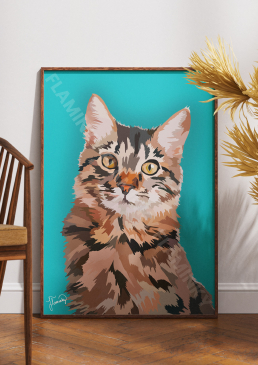

The IKEA Effect and the Rise of the ‘AI Artist’
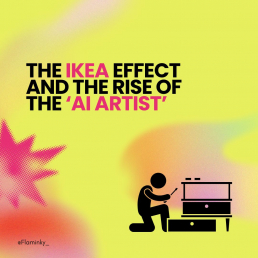
There’s a peculiar psychological phenomenon known as the IKEA Effect — named after the Swedish flat-pack furniture empire. It describes how people place disproportionately high value on things they’ve partially created themselves. In other words, if you build it (even just part of it), you’re likely to love it more.
You spend an hour assembling a wobbly bookshelf, and suddenly, it’s not just furniture — it’s a personal triumph. A reflection of you. A thing you made. That pride and ownership are powerful. But what happens when we apply the IKEA Effect to art — more specifically, AI-generated art?
The New Wave of “AI Artists”
In the past few years, we’ve seen a rise in people proudly calling themselves AI artists. Using tools like Midjourney, DALL·E, or Leonardo.Ai, users input a few descriptive words — a “prompt” — and in seconds, a beautiful, fully-formed image appears.
The result can be stunning, surreal, and emotionally evocative. And yet… the person behind it has only provided the ingredients. The AI is the real chef. Or rather, the entire factory.
This is where the IKEA Effect kicks in. Because the user typed the words, they feel they’ve created the art. Just like assembling a table with Allen keys, that sense of partial authorship gives them a burst of pride — and for some, that’s enough to claim a title like “artist.”
Prompting ≠ Craft
Let’s be clear: Prompt engineering is a skill, especially when creating complex or consistent series of images. But is it the same as studying anatomy for years to draw a human figure? Is it the same as mastering oil paint, or understanding light and texture, or dedicating your life to understanding how art moves people?
Many traditional artists feel a growing sense of frustration. They’ve trained for years — often at great personal and financial cost — to hone their craft. And now, a person with no formal experience can type “renaissance-style portrait of a cat playing the violin in a flower field” and get instant praise, clicks, or even paid commissions.
That’s not to say AI art can’t be beautiful or meaningful. But should it be valued the same way? Should the prompt engineer be celebrated like a painter, illustrator, or photographer?
Art vs Assembly: The Emotional Disconnect
Art is often about the process — the hours of sketching, revising, reworking, and the human stories behind each mark. AI shortcuts this entirely. There’s no mistake-making, no happy accident, no soulful imperfection. It’s mass generation dressed as creativity.
AI art feels good to the maker, because they’ve added the egg to the pre-made cake mix. But that’s not baking. It’s assembling. And while there’s nothing wrong with a Betty Crocker moment now and then, we should be careful about how we frame it — especially when real bakers have spent years perfecting their recipes.
The Economic and Cultural Shift
There’s also an economic layer here. Many artists now find themselves priced out of commissions — replaced by AI tools and those who can use them to undercut with speed and scale. Others see their styles mimicked and their work fed into the very data sets that power these AI tools, without permission or credit.
This isn’t just about individual recognition — it’s about the value we place on human creativity in a world increasingly defined by machines.
Final Thoughts: Don’t Dismiss the Makers
The IKEA Effect can be a wonderful thing — it reminds us that participation creates pride. But in art, we need to ask: How much participation is enough to justify the label of “artist”?
At Flaminky, we believe creativity comes in many forms. AI can absolutely be a tool in the creative toolbox. But let’s not forget — or undervalue — the people who have dedicated their lives to understanding and creating true art.
Because in a world where AI can do almost anything, what might become rare — and truly valuable — is the human hand, human struggle, and human story behind the work.
The Hidden Environmental Cost of Your AI Prompt
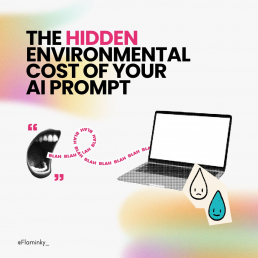
When we ask artificial intelligence to generate an image, video, or piece of writing — whether that’s a holiday itinerary, a blog post, or a deepfake of a celebrity eating a Greggs sausage roll — we rarely think about what it takes to make that response happen. It’s just a line of text and a click, right?
Wrong.
Behind every AI-generated answer is a massive environmental footprint, one that’s growing faster than we realise — and that footprint has a name: data centres.
The AI Industry’s Dirty Secret
Every time you interact with AI — whether it’s ChatGPT, Midjourney, DALL·E, or Google Veo — your request is processed by thousands of computers stored in vast server rooms. These servers don’t run on magic. They consume electricity, pump out heat, and require huge amounts of water to cool down. This is particularly true for large language models and video-generation AIs, which are computationally intensive.
And with the world’s obsession with AI skyrocketing, the environmental cost is scaling with it.
Water: The Invisible Cost of Intelligence
A single AI model, during its training phase, can consume millions of litres of water. When AI companies say they’re “training” a model, they’re essentially putting thousands of GPUs (graphics processing units) through months of high-intensity computation, which generates immense heat.
How is that heat managed?
Water cooling systems.
According to a 2023 report, training OpenAI’s GPT-3 in Microsoft’s data centres consumed approximately 700,000 litres of clean water. And that’s just one model. Every AI response you prompt after that adds to the ongoing usage. Meta, Google, and Amazon also use millions of litres of water per day to keep their AI servers stable and functioning.
Electricity and Carbon Emissions
It’s not just about water. AI consumes an astonishing amount of power, often sourced from fossil-fuel-heavy grids. In 2022, data centres accounted for roughly 1–1.5% of the world’s electricity consumption — and with AI exploding in popularity since then, that figure is only climbing.
To put things in perspective:
-
Generating one AI image can use as much power as charging your phone 30 times.
-
Training a single AI model can emit up to 284 tonnes of CO₂ — that’s the equivalent of 60 petrol cars driving for a year.
What Even Is a Server Room?
Imagine a gigantic warehouse filled with rows upon rows of machines stacked in towers — constantly running, constantly humming, constantly consuming power. These are server farms, and they’re the backbone of the internet and AI.
The irony? Some of these server centres are now being built in deserts, including Arizona — one of the driest places on Earth — where water for cooling is already in scarce supply.
AI Sustainability: Greenwashing or Progress?
Tech giants like Google and Microsoft claim they are working towards carbon neutrality and “green AI.” Some are investing in air cooling, renewable energy, and liquid immersion cooling (where servers are dunked in non-conductive liquid to keep them cool without evaporating water).
But critics argue these efforts are slow and performative — especially as companies race to release bigger, faster, and more powerful AI tools without pause. If each model release requires exponentially more energy, is “sustainability” even possible at that scale?
What Can We Do?
We’re not saying “don’t use AI” — it’s an incredible tool and part of the future. But we need awareness and responsibility. Here’s what that can look like:
-
Use AI mindfully — not just for novelty or spammy content.
-
Support AI tools from companies making transparent, measurable green efforts.
-
Advocate for tech policy and regulations that hold AI companies accountable for environmental impacts.
-
If you’re a creator, brand or business, ask how your content is being made — and what it costs the planet.
Final Thoughts: There’s No Such Thing as a “Free” Prompt
Just because AI feels weightless doesn’t mean it’s without weight. Every time we ask a bot to dream, something in the real world works harder, burns hotter, and drinks more water to make that dream come true.
At Flaminky, we believe in technology that not only fuels creativity but does so responsibly. In a world increasingly shaped by code, it’s time we thought beyond the keyboard — and considered what our prompts are really asking of the planet.
Google Veo 3 and the Blurring Line Between Reality and Illusion
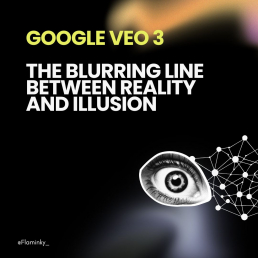
Google’s recent unveiling of Veo 3, its most advanced AI video generation tool yet, marks a massive leap in artificial intelligence — and not without consequence. With the ability to generate photorealistic, cinematic-quality video from text prompts, Veo 3 raises exciting possibilities but also serious concerns across industries and societies. From the world of cinema to the realms of misinformation, jobs, and creativity — nothing will remain untouched.
What Is Google Veo 3?
Think ChatGPT, but instead of words, it produces full videos. Veo 3 can create scenes from scratch based on natural language descriptions, add realistic camera movements, lighting, and even emotional tones to visuals. It can emulate specific film styles, recreate environments, and build entire narratives from a prompt. This isn’t just animation — this is AI-generated cinema.
The Future of Cinema and Content Creation
Let’s be honest: Veo 3 is a game-changer for filmmakers, marketers, and content creators. Agencies that once required entire crews, cameras, actors, editors, and thousands in production costs can now conjure an entire campaign with just a keyboard and an imagination.
On the flip side? Real creatives, from set designers to DOPs, may find their roles threatened.
This could give rise to a new kind of filmmaker — a “prompt director” — but what about the value of human-crafted stories, imperfections, and the magic of on-set collaboration? Will we crave authenticity in a world where everything can be perfectly faked?
Deepfakes, Fake News & Dead Internet Theory
Veo 3 brings the Dead Internet Theory uncomfortably closer to reality — the idea that much of the internet is no longer created or interacted with by real people, but by bots and AI.
Soon, you may not be able to tell if that video of a celebrity saying something inflammatory is real. Deepfakes, which once required high technical knowledge, are now democratised — and that’s dangerous. Combine this with political agendas, fake news, and conspiracy echo chambers, and we’re looking at a future where truth becomes optional.
Expect a flood of AI-generated media that’s indistinguishable from reality. And if people already distrust mainstream news, how will they cope when nothing can be verified?
The Scammer’s New Playground
Imagine receiving a video call or message from a loved one — or so you think — only to realise it was a scammer using Veo-like tools to deepfake their likeness. The tools that were once the preserve of high-end studios are becoming accessible to anyone. The scammer from Facebook Marketplace doesn’t need Photoshop anymore — they have Veo 3.
AI-generated misinformation could cause identity theft, reputational damage, and even geopolitical tensions. We’re not just fighting misinformation — we’re fighting hyperrealism.
Marketing Agencies and the Collapse of “Real”
From brands creating entire ad campaigns without shooting a single frame to influencers that don’t exist, Veo 3 may accelerate the AI-first marketing era. It’s cheaper, faster, and often indistinguishable from real footage. But as more brands embrace it, the human touch — that raw authenticity that builds trust — may start to erode.
What happens when every influencer is AI-generated, every advert a prompt, every model digitally sculpted?
The Creativity Question
Veo 3 brings us back to the central question: What is creativity in the age of AI?
Are we entering a post-human artistic phase, where ideas matter more than execution? Or are we devaluing the skill, effort, and emotional depth behind human-made art?
There’s no doubt AI tools like Veo 3 can assist creatives — offering new ways to ideate, prototype, and tell stories. But we must also be aware of how easy it is to let the machine do all the work — and how quickly human talent can become undervalued, or even obsolete.
Final Thoughts: A Fork in the Algorithm
Google Veo 3 is both a revolution and a warning. It offers power, convenience, and breathtaking possibilities — but also a mirror to the darkest parts of our digital culture: manipulation, job displacement, surveillance, and the erosion of truth.
As we marvel at what’s possible, we also need to ask better questions: Who controls these tools? Who verifies what’s real? Who gets left behind?
At Flaminky, we celebrate the intersection of culture, tech, and society — and right now, we’re at one of those defining crossroads. The future isn’t just coming fast… it’s being generated.
Female Torso - £25.00
Female Torso
£25.00
Celebrate the timeless elegance of the human form with this digital drawing of a female torso, created to emulate the texture and depth of traditional pencil work. This piece blends the precision of digital art with the warmth and softness of hand-drawn shading, resulting in a modern yet classic study of form.
Ideal for art enthusiasts, figure drawing collectors, or anyone seeking tasteful and minimalist décor, this artwork offers a subtle, sophisticated focal point for any space.
Style
Digital illustration with traditional pencil effect
Subject
Female torso (artistic study)
Mood
Minimalist, elegant, and expressive
Series
Traditional
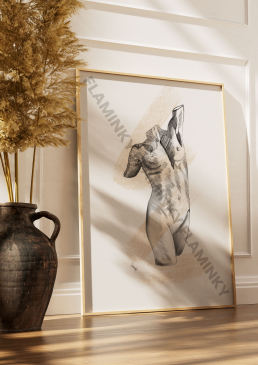

Turquoise House - £25.00
Turquoise House
£25.00
Add a splash of artistic charm to your space with this digital design of a turquoise house, featuring a soft watercolour effect with a crisp black outline. This piece combines the gentle fluidity of traditional watercolour with the precision of digital art, creating a striking yet calming aesthetic.
Perfect for home décor enthusiasts, architecture lovers, or anyone who enjoys unique, hand-rendered designs, this illustration stands out as a modern yet timeless accent piece.
Style
Digital watercolour with hand-drawn black outline
Subject
Turquoise house
Effect
Soft, painterly watercolour feel paired with bold line work
Series
Houses
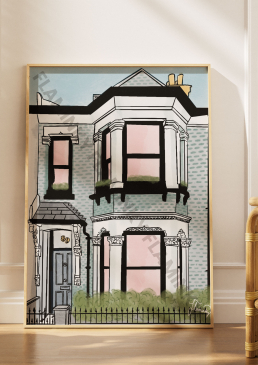

Pink Princess Philodendron - £25.00
Pink Princess Philodendron
£25.00
Celebrate the beauty of houseplants with this digital portrait of a Pink Princess Philodendron, featuring its signature variegated leaves in soft greens and pinks. The pastel pink background enhances the plant’s delicate tones, creating a soothing and contemporary art piece perfect for plant lovers and modern interiors.
This artwork blends clean, hand-drawn digital lines with a soft colour palette, making it an ideal choice for botanical art collectors, plant parents, or anyone looking to add a fresh, natural touch to their décor.
Style
Hand-drawn digital illustration
Subject
Pink Princess Philodendron (houseplant)
Background
Pastel pink
Series
Plants


Giants Causeway - £25.00
The Giant’s Causeway
£25.00
Capture the magic of Northern Ireland’s iconic coastline with this digital illustration of the Giant’s Causeway. Inspired by the dramatic hexagonal basalt columns and sweeping ocean views, this artwork brings one of the world’s most famous natural wonders to life in a modern, vibrant style.
Featuring a hand-written title at the bottom of the image, the piece combines artistic expression with a sense of place — making it perfect as a travel keepsake, décor for lovers of rugged landscapes, or a thoughtful gift for anyone inspired by nature’s beauty.
Style
Hand-drawn digital art
Subject
Giant’s Causeway (Northern Ireland)
Series
Places


Welsh Corgi - £25.00
Welsh Corgi
£25.00
Brighten your space with this adorable digital illustration of a Welsh Corgi, featuring the breed’s signature charm and a neutral, open-mouth smile. The soft yet lively pink background adds a playful pop of color, making it perfect for dog lovers and art enthusiasts alike.
Part of our Dog / Pet Series, this piece combines clean digital artistry with warm character a must-have for Corgi fans or anyone who appreciates vibrant, modern pet portraits.
Style
Hand-drawn digital art
Subject
Welsh Corgi with open-mouth neutral smile
Background
Pink
Series
Dog / Pet Series
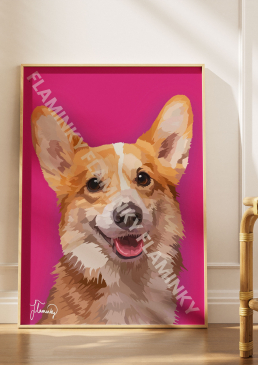

Yr Wyddfa Summit 1083m!
This weekend, my partner Kyle and I climbed Yr Wyddfa (Snowdon), 1,083m, the highest mountain in Wales, and I couldn’t be prouder. Not just because of the climb itself, but because of what it represented.
Back in May, I was in a car accident that left me injured and with severe driving anxiety. So before even lacing up my hiking boots, I faced another mountain: driving over 5 hours up to North Wales. For Kyle’s birthday trip, I wanted to make it happen. And I did.
Standing at the summit of Yr Wyddfa felt like more than just a breathtaking view. It felt like reclaiming confidence, proving to myself that healing isn’t linear, and that little steps can lead to big victories.
The climb itself was challenging but beautiful, with steady inclines, changing landscapes, and that rewarding feeling of moving closer to the sky with every step. Each moment up the mountain was a reminder that resilience isn’t just about pushing through pain; it’s about showing up for yourself even when it’s hard.
Sometimes progress doesn’t look like huge leaps. Sometimes it looks like long drives, steady climbs, and small victories adding up to something big. And this weekend, reaching the top of Wales’ highest peak with Kyle by my side felt like a victory I’ll never forget.

